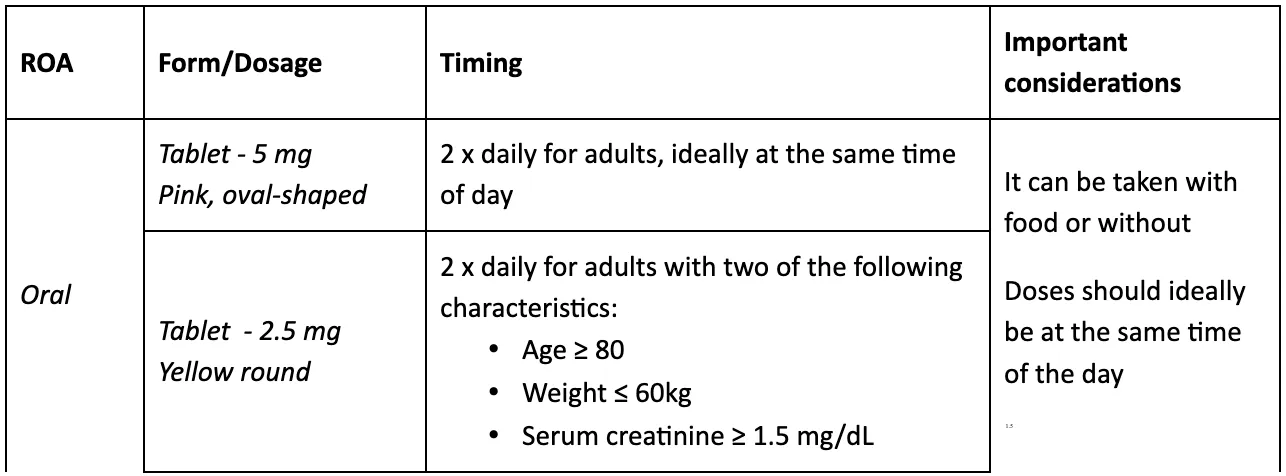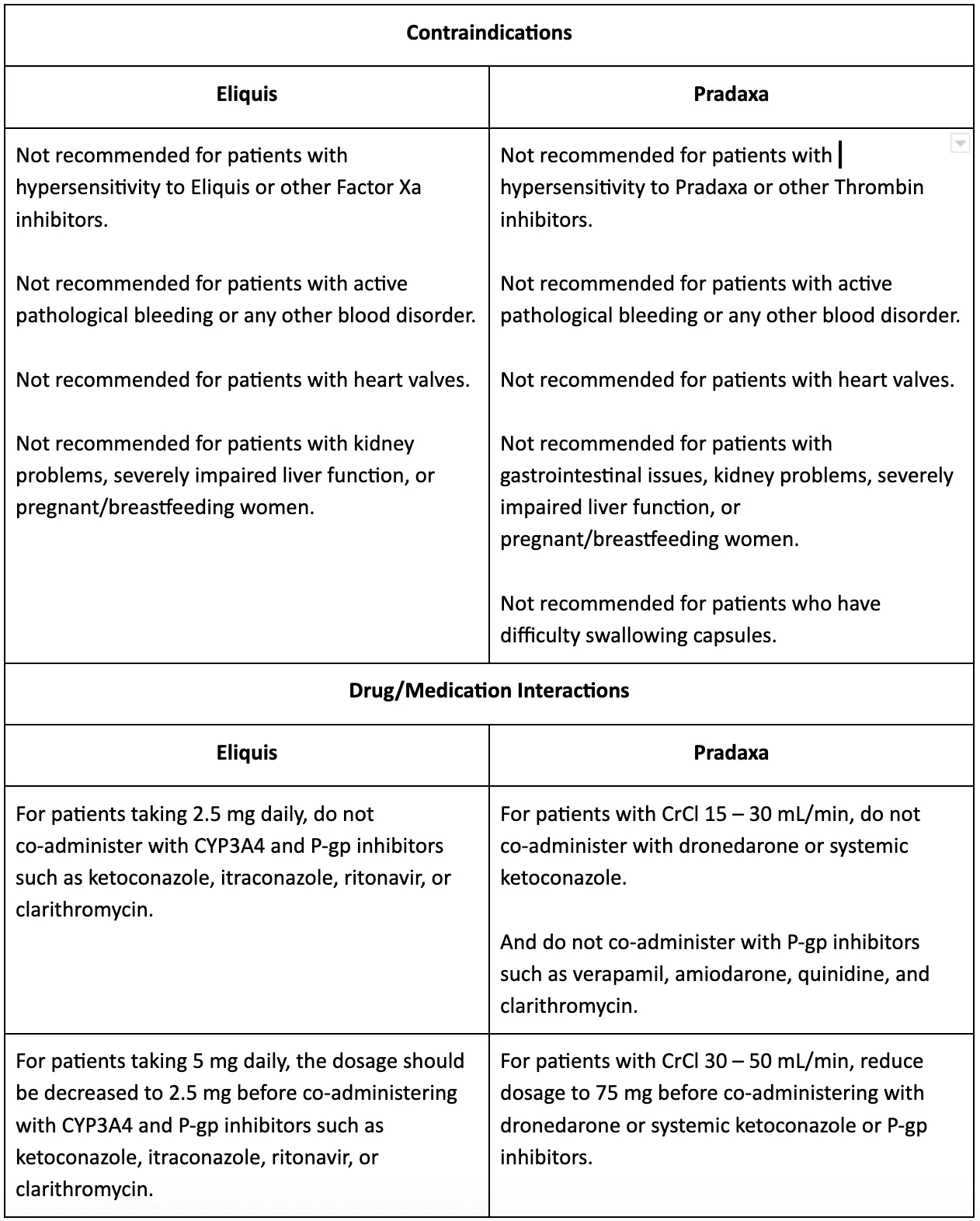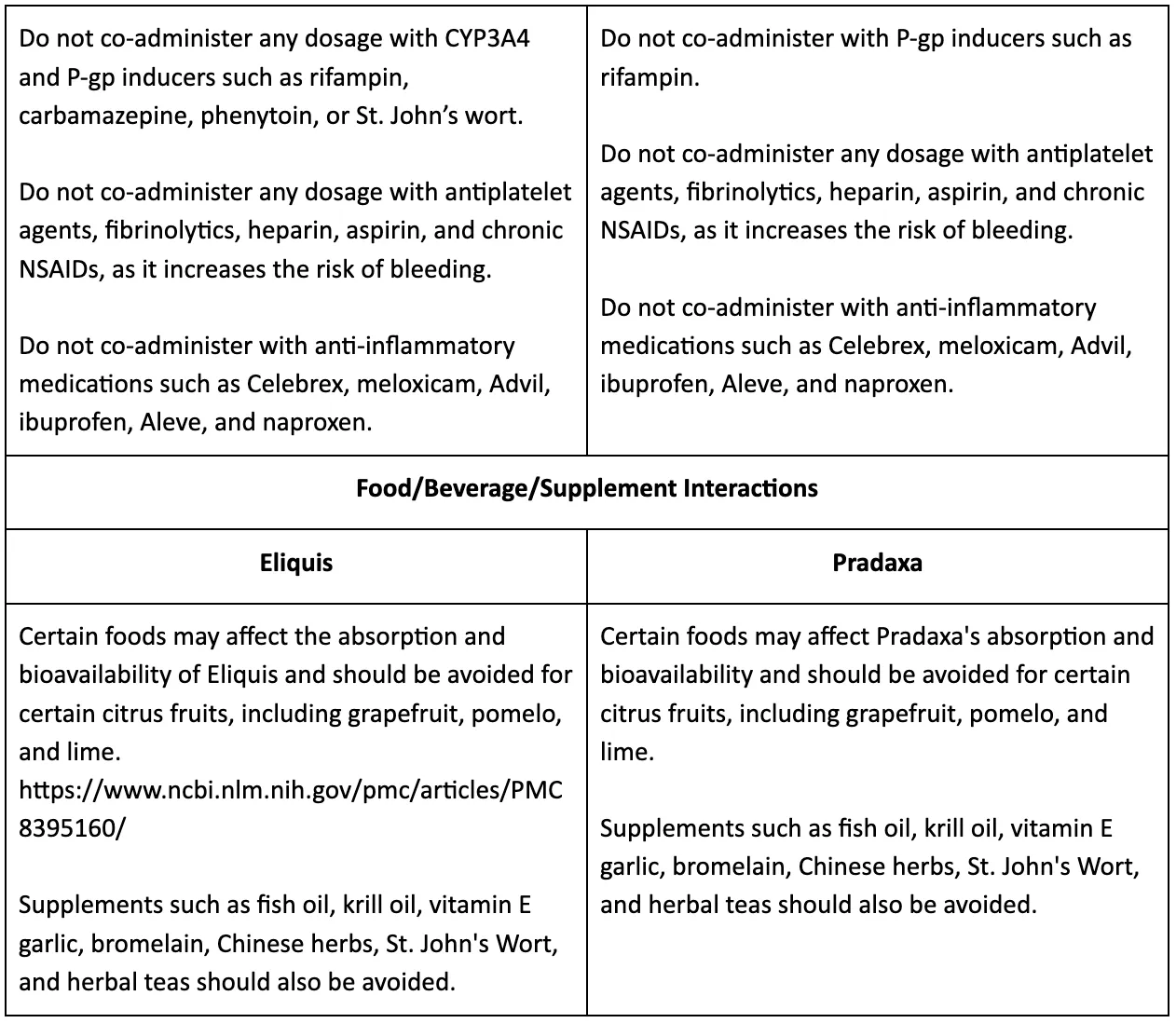Your session is about to expire
Eliquis vs Pradaxa
Introduction
Deep vein thrombosis (DVT) results from blood coagulation, i.e., the formation of blood clots within the body's deep veins, most commonly the pelvis and lower limbs. While this condition may include symptoms such as pain, redness, numbness, warmth, or swelling in the affected area, it is not always necessary, making it challenging to diagnose.
Furthermore, if DVT is left untreated, there is a high risk of blood clots breaking apart and traveling to other blood vessels, such as the pulmonary artery, causing a pulmonary embolism or to the brain, resulting in a stroke.
For patients with cardiovascular disease or atrial fibrillation, DVT is a serious concern, and anticoagulants such as Eliquis and Pradaxa are prescribed to prevent clots from forming. While these medications produce the same result, their mechanism of action and dosages are different.
About Eliquis and Pradaxa
What is Eliquis?
Eliquis is a brand name for the compound apixaban, which belongs to a class of drugs known as direct oral anticoagulants (DOACs) or novel oral anticoagulants (NOACs). Developed by Bristol-Myers Squibb and FDA-approved in 2012, this drug works by inhibiting a specific clotting factor known as Factor Xa.
Factor Xa is a crucial component in the blood clotting process, responsible for activating prothrombin, which creates thrombin, an enzyme necessary to form the fibrous structure of blot clots. By inhibiting this process, Eliquis stops the blood coagulation cascade without directly affecting other processes, such as platelet aggregation.
What conditions is Eliquis approved to treat?
Eliquis is FDA-approved to treat the following conditions:
- Deep vein thrombosis (DVT)
- Pulmonary embolism
- Reducing the risk of stroke and system embolisms in non-valvular atrial fibrillation
- Prevention treatment, i.e., prophylaxis for venous thromboembolism (VTE) after hip or knee replacement surgery.
How does Eliquis work for DVT?
Eliquis works as a therapy for DVT by reducing the activity of Factor Xa, which can stop the existing blood clots and lowers the risk of new clots forming in the deep vein, thus treating existing DVT and preventing more clots from forming.
What is Pradaxa?
Pradaxa is a brand name for the medication with the generic name dabigatran, a compound also classified as a DOAC. Manufactured by Boehringer Ingelheim, it was the first DOAC approved by the FDA in 2010.
Like Eliquis, Pradaxa prevents blood coagulation but at a different stage of the cascade, inhibiting thrombin instead of Factor Xa.
What conditions is Pradaxa approved to treat?
Similar to Eliquis, Pradaxa is FDA-approved for treating:
- Deep vein thrombosis (DVT)
- Pulmonary embolism
- Reducing the risk of stroke and systemic embolisms in atrial fibrillation
- Preventative treatment for venous thromboembolism after knee or hip replacement surgery
How does Pradaxa work for DVT?
Pradaxa treats DVT by directly inhibiting thrombin by binding to it so it cannot convert fibrinogen into fibrin, the fiber that forms the structure of a blood clot. This mechanism of action also stops blood coagulation, prevents the growth of blood clots, and reduces the chances of new clots forming.
Effectiveness
How effective are Eliquis and Pradaxa for treating DVT?
Eliquis and Pradaxa are highly effective at treating deep vein thrombosis (DVT) and preventing it from recurring. Compared to traditional therapies, they have a faster onset of action, do not require routine blood monitoring, and have fewer drug interactions.
In the AMPLIFY study, the effects of Eliquis were studied in patients with acute DVT. It was seen to be non-inferior to conventional therapies in terms of slowing blood clot growth and managing reoccurrence. At the same time, Eliquis also showed a significantly lower rate of adverse reactions, such as major bleeding.
The Re-COVER study showed similar results when comparing the effects of Pradaxa to warfarin, one of the most commonly prescribed medications for DVT. However, studies have also shown that Pradaxa increases the chances of heart attack in patients with non-valvular atrial fibrillation compared to warfarin.
Dosage information
How is Eliquis administered for DVT?
Eliquis is available as an oral tablet in 2.5 mg and 5 mg dosage strengths. To treat DVT, it is taken in two phases, an initial treatment phase followed by a maintenance phase.
The initial treatment runs for approximately seven days, during which patients are given a higher dose of Eliquis to reduce blood clot growth rapidly. Then the dosage is decreased in the following maintenance phase, and patients continue to take Eliquis for 3 – 6 months.
The oral tablet must be swallowed whole without chewing with or without food. If patients have difficulty slowing the tablet, it can be crushed and then sprinkled on top of soft foods such as apple sauce or mixed in water or apple juice. However, it cannot be stored and must be swallowed promptly.
If a dose is skipped or missed unintentionally, patients should take a tablet as soon as possible, provided it is at least 6 hours before the next dose.
Eliquis should not be suddenly stopped if treatment is to be discontinued, as this can significantly increase the risk of stroke. Healthcare providers must provide a replacement anticoagulant before patients stop taking Eliquis or move on to a new therapy.
Eliquis dosage information

How is Pradaxa administered for DVT?
Pradaxa comes as an oral capsule that comes in both 75 mg and 150 mg strengths. For treating deep vein thrombosis (DVT), it is given in two phases, similar to Eliquis, an initial treatment phase followed by a maintenance phase.
During the first phase, patients are given a higher dose taken twice a day for 5 – 10 days. Then the dosage is lowered in the maintenance phase, but patients continue to take Pradaxa twice daily for 3 – 6 months or as recommended by a healthcare professional.
The capsule needs to be swallowed whole without chewing or crushing. Patients who have trouble swallowing capsules cannot open a Pradaxa capsule and swallow the pellets as it can result in an overdose as the body may absorb more Pradaxa than recommended, which can increase the risk of major bleeding.
If a dose is missed or skipped, patients can take the missed tablet provided it is at least 6 hours prior to the next scheduled one. If there is insufficient time, doses should not be doubled to compensate for the missed one.
Additionally, Pradaxa treatment should not be abruptly stopped as it can increase the chances of stroke. If patients are being moved from warfarin to Pradaxa, discontinue warfarin and only start Pradaxa once the INR (international normalized ratio) is under 2.0.
If converting from Pradaxa to warfarin, start warfarin based on creatinine clearance (CrCL), as given below:
- CrCl ≥ 50 mL/min, start warfarin 3 days before stopping Pradaxa
- CrCl 30- 50 mL/min, start warfarin 2 days before stopping Pradaxa
- CrCl 15-30 mL/min, start warfarin 1 day before stopping Pradaxa
Pradaxa dosage information

Side Effects
What are the most common side effects of Eliquis?
The most common side effect seen with Eliquis includes the following:
- Chest pain or tightness
- Nausea
- Face and tongue swelling
- Dizziness and headaches
- Unexplained bruising
- Unexplained bleeding from gums and nose
- Bleeding from wounds or needle injections
- Heavy menstrual periods
- Numbness or tingling, especially in lower limbs and feet
Are there any potential serious side effects of Eliquis?
Potential serious side effects of Eliquis that require immediate medical intervention include:
- Prolonged unexpected bleeding from gums and nose
- Prolonged bleeding following a wound or injection
- Frequent nosebleeds
- Red, pink, or brown urine
- Red or black stools that resemble tar
- Coughing up blood or blood clots
- Vomiting blood or vomit looks like pellets or coffee grounds
- Painful swelling of joints
- Trouble breathing or wheezing headache
- Loss of movement in lower limbs
What are the most common side effects of Pradaxa?
Common side effects of Pradaxa include the following:
- Chest tightness or pains
- Face or tongue swelling
- Burning in the throat
- Dizziness
- Heartburn, acidity, and belching
- Stomach discomfort, indigestion, nausea
- Diarrhea or constipation
- Joint pain, swelling, or discomfort joint
- Bruising
- Gum bleeding and nose bleeds
- Heavier than normal menstrual bleeding in women
Are there any potential serious side effects of Pradaxa?
- Unexplained bruising and bleeding
- Frequent bleeding of the gums and nose
- Uncontrolled bleeding following a cut
- Vomiting of blood or vomit looks like coffee grounds
- Coughing up blood or blood clots
- Pink or brown urine
- Black, tarry, or bloody stools
- Severe rectal bleeding
- Gastrointestinal hemorrhages
- Brain hemorrhages
Contraindications and interactions
Warnings and general precautions for Eliquis and Pradaxa
Eliquis and Pradaxa are contraindicated in patients with active pathological bleeding or any other blood disorder since both are blood thinners, increasing the risk of major bleeding that can become serious and potentially fatal.
Additionally, these medications are not recommended for patients with artificial heart valves, kidney problems, liver problems, or pregnant and breastfeeding women.
Moreover, abruptly stopping or interrupting Eliquis or Pradaxa can disrupt treatment and increase the risk of DVT recurrence. Therefore, neither should be stopped without an appropriate replacement medication.
In the case of severe bleeding or emergency surgery, there are antidotes available for both medications that can reverse the anti-coagulation effects rapidly within 4 – 6 hours, as given below:
- For Eliquis: andexanet alfa
- For Pradaxa: idarucizumab
Contraindications and important interactions for Eliquis and Pradaxa


Cost Comparison
How much do Eliquis and Pradaxa cost?
The price for the brand-name medications, the prices are as follows:
- 60 tables of Eliquis (5 mg) averages around $600, which comes to $10 per day, assuming 5 mg is the total dosage per day
- 60 capsules of Pradaxa (75 mg) averages $530, equivalent to $8 per day, assuming 75 mg is the total daily dosage.
Popularity of Eliquis and Pradaxa
Eliquis and Pradaxa are widely used anticoagulant medications in the United States for treating DVT along with atrial fibrillation and pulmonary embolism.
Eliquis is the most popular anticoagulant, with over 13 million prescriptions in 2020, making it the 48th most prescribed medication in the US. Pradaxa ranks lower as the fourth most commonly prescribed anticoagulant, with just over one million prescriptions, making it the 306th-ranked medication in the US.
Conclusion
Takeaway
Eliquis and Pradaxa are effective medications for treating deep vein thrombosis as they target the blood clotting process but inhibit different components specifically. Eliquis is a Factor Xa inhibitor, and Pradaxa is a thrombin inhibitor.
Despite their similar effect at preventing blood clots, in recent years, Eliquis has risen in popularity because it is comparatively more tolerated by patients, and it has the option to be crushed and mixed with soft foods or water, which makes it more suitable for patients who have trouble swallowing the oral tablet.